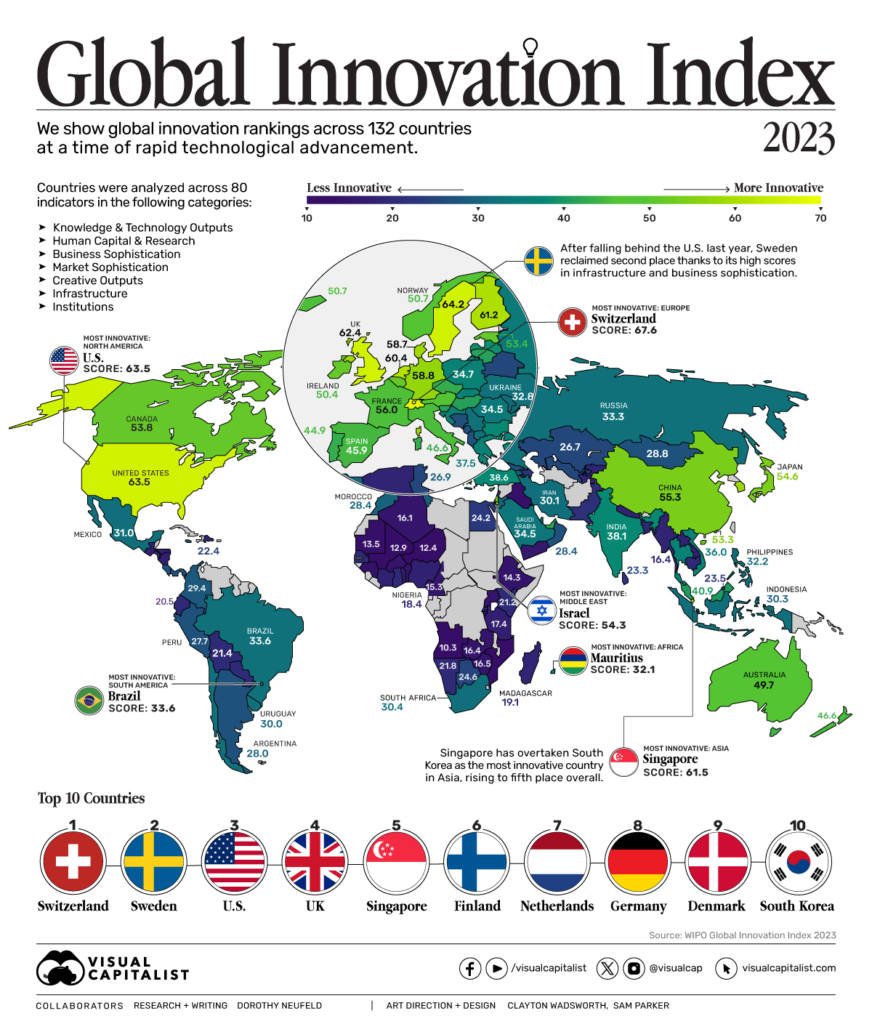
The Visual Capitalist (2034, November 14) Ranked: The Most Innovative Countries in 2023 https://www.visualcapitalist.com/most-innovative-countries-in-2023/
Creating Significant Learning Environments

The Visual Capitalist (2034, November 14) Ranked: The Most Innovative Countries in 2023 https://www.visualcapitalist.com/most-innovative-countries-in-2023/
Steven Johnson’s book How We Got to Now: Six Innovations That Made the Modern World is one of the most eye opening books I have read.
In Part 2 of this episode, Dr. Tilisa Thibodeaux shares her personal and professional challenges in adopting the Learner’s Mindset. Tilisa shares some of the challenges she faced in helping others in her team adopt the Learner’s Mindset.
Listen to this Podcast on Spotify – https://open.spotify.com/episode/0U4DHVwdCxlM4lzg5AH4AP?si=2acf0b4ab9d04bfc
A recent question by one of my graduate students reveals that while the name or phrase may change or fall out of favor, but if the idea is good it will persist in a slightly different format.
In an online class meeting, I cautioned my graduate students on using the phrase “disruption” or “disruptive innovation” in their innovation proposals because disruption has a tendency to convey a negative connotation in an educational setting. Teachers don’t like disruptions to their classes.
The following question and response (which I do have permission to share) reveal the challenge of conveying meanings especially when some names or labels have the potential to be misunderstood.
Question
I do have a question about using the word “disruption”. As that is the name of this course, I understood it to be one of the qualifiers of our proposal. As a student, I now understand that disruption is not negative. Could it be part of my charge to change that rhetoric? Is there something more fundamentally wrong with the theory of disruption? Why did we read Clayton Christensen’s article in week one, if it is a term we should avoid? Do you agree with Christensen?
My Response
You do ask a really good question about disruptive innovation. If I recall my memory correctly Christensen coined the term disruptive technologies back in an article in 1996 and then he later referred to this as disruptive innovation in his 1997 book Innovator’s Dilemma. Many people now refer to Christensen’s ideas on how technology can disrupt the change process as the theory of disruptive innovation which I would argue is still quite well supported, but like any theory, there are supporters and detractors. I am on the supporter side, but I am also aware of the limitations. In a much earlier (2009-2010) version of this disruptive innovation course which was called a different name in a different institution, I had my students read Christensen’s book Disrupting Class: How Disruptive Innovation Will Change the Way the World. Back in late 1990, I would have my students read the Innovator’s Dilemma, so I have been a longtime supporter of Christensen’s ideas. While I may have shifted the way I talk about disruptive innovation and more importantly ask my students to talk about disruptive innovation, I still believe we need to be aware of how it works and take advantage of the opportunities it offers.
The change in language is just a matter of applying the old adage/proverb…you can catch more flies with honey than with vinegar. People don’t want to be disrupted and it can often scare people, especially those who want to be safe. Over the past 10 years, we have seen a shift in our campuses toward the use of “safe spaces” and “trigger warnings” and in 2015 when Lukianoff and Haidt argued in the Atlantic article The Coddling of the American Mind that overprotection is having a negative effect on university students I knew I needed to shift the language a bit in the course where I used the notion of disruptive innovation. I have been trying to bring about change in learning environments since the late 80’s so I have learned many valuable lessons. I learned that you have to take a very broad approach and consider many different factors and while the facts or data may be right many people are still afraid of the data and some just like things the way they are…they don’t want to be disrupted. In the post People who like this stuff…like this stuff I point to 4 key factors that you need to address to bring about change in the learning environment. I will be asking my student to apply these ideas in an upcoming course on organizational change.
To summarize, the adage you can catch more flies with honey than with vinegar is very true, especially in an educational setting. Be careful how you use the term disruptions but still use the ideas. Remember we want to improve or change the world one learner at a time.
It took me a while to realize I could speed up this process if I didn’t scare my learners first.
We encourage you to move beyond using technology as a quickfix and focus on the learning to drive the context. The following resources were highlighted in the video:
Why We Are Wasting EdTech Dollars?
https://www.harapnuik.org/?p=7672
Why Schools Must Move Beyond One-to-One Computing
https://novemberlearning.com/article/why-schools-must-move-beyond-one-to-one-computing/
Alan November on the ‘$1000 Pencil’ and Why Edtech Companies Aren’t Pushing the Envelope
https://www.edsurge.com/news/2016-08-15-alan-november-on-the-1000-pencil-and-why-edtech-companies-aren-t-pushing-the-envelope
Thibodeaux, T. N., Harapnuik, D. K., Cummings, C. D., & Wooten, R. (2017). Learning all the time and everywhere: Moving beyond the hype of the mobile learning quick fix. In Keengwe, J. S. (Eds.). Handbook of research on mobile technology, constructivism, and meaningful learning. Hershey, PA: IGI Global. Access draft file from: https://www.dropbox.com/s/bk0epb76sr3u27v/Learning%20All%20the%20Time%20and%20Everywhere-InPressDraft.pdf?dl=0
Individualized Instruction vs Personalized Learning
https://www.harapnuik.org/?p=4236
Personalized learning and the new Behaviorism
https://www.harapnuik.org/?p=7485
Personalized Learning
https://www.harapnuik.org/?p=7887
Reflex
https://www.reflexmath.com/
Dreambox Learning
https://www.dreambox.com/
Edgenuity
https://www.edgenuity.com/products-and-services/personalized-learning-solutions/#courseware
iPad in Education: World Results
https://www.apple.com/ca/education/docs/ipad-in-education-results.pdf
Make learning more effective and engaging with Chromebooks
https://edu.google.com/products/chromebooks/?modal_active=none